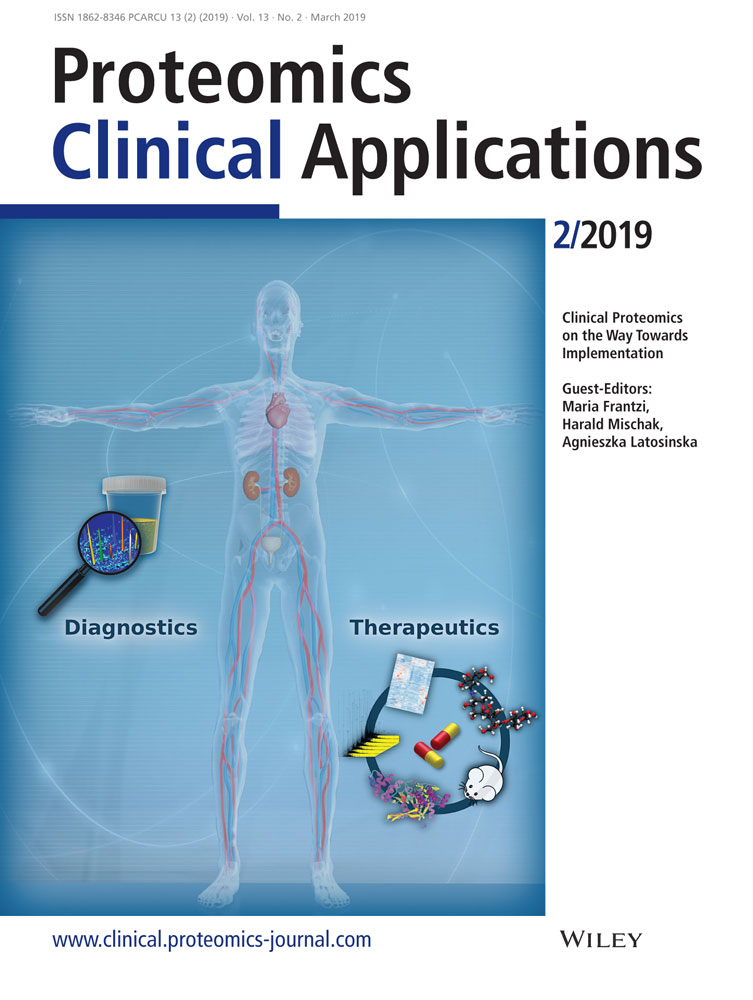Clinical Proteomics on the Path Toward Implementation: First Promises Delivered
We are very glad to present this special issue focused on the implementation of clinical proteomics. More than 10 years ago this journal was established, and one of the first papers already provided guidance on relevant issues in reporting of clinical proteomics studies.1
At that time clinical implementation was still far away, but nevertheless expected to take place in the next few years. Evidently, this was not the case. The failure to deliver on these certainly highly optimistic expectations was attributed to multiple factors, probably to a large degree it was a result of little or no communication between the proteomics scientists and clinicians.
In the following years the field progressed, evidence for the value of proteomics in potential clinical applications was presented in multiple manuscripts, but the step from promising results to actual implementation was generally not undertaken. Major hurdles were identified, among others, lack of funding to perform the required large validation studies and lack of interest in publishing such investigations, both related to the limited novelty, the high cost, lack of knowledge on regulatory issues, and a vague definition of a context of use.2 However, some efforts were brought forward and by now, clinical trials to investigate the use of proteomics in patient management have been initiated, some even completed.
In this special issue the most prominent examples of proteomics on the road towards clinical application, or already implemented, are presented. In an effort to comprehensively present the current state-of-the-art, more than 3000 scientists active in the field were invited to contribute. As a result, this issue represents an attempt towards a critical and comprehensive overview of the current situation in clinical implementation, and also pinpoints major hurdles that have to be overcome, including, wherever possible, suggestions on how to proceed.
Most of the focus in clinical proteomics research has been on the development of biomarkers, also since biomarkers have a more immediate impact: if proven valuable (accurate and cost-efficient) implementation of biomarkers can be directly aimed at, for disease diagnosis, prognosis, and guiding intervention. In a review by He,3 the application of proteomics biomarkers in clinical trials is presented, based on the information available in the Clinical Trials Database. This important paper demonstrates well that first proteomics-based biomarkers are applied in clinical assessment. It is obvious that the number of trials does not match well the number of reports on clinical proteomics, indicating major hurdles in implementation. In a viewpoint contributed by Vlahou,4 where the author emphasizes on the potential of clinical proteomics especially in the growing field of personalized medicine, issues that stand in the way of implementation, and potential solutions are covered.
A more challenging yet emerging field appears to be the exploitation of proteome analysis in the identification of drug targets and in the process of drug development. Obviously, this is a by far less direct approach. Nevertheless, considering that most of the druggable targets are proteins, also the availability of advanced technologies and an ever-growing number of valid datasets, approaches in this direction seem to appear promising. It is comprehensible that proteomics enables identification of novel drug targets and deepens our understanding of the drugs’ mechanisms of action. In a review in this special issue we present the current status of this emerging field,5 which is expected to see exponential growth in the near future. The article covers potential breakthroughs in proteomic profiling (such as thermal proteome profiling) for the characterization of binding partners of a drug, as well as the efforts of proteomics discovery studies to characterize the disease's underlying pathology and possible resistance mechanisms to certain treatment regimes.
A quite unexpected, but currently extremely worrying issue is data protection. The scientific community and funders alike request or even mandate that data which forms the basis of any publication are being made publicly available, e.g. via repositories like PRIDE. However, huge uncertainty is becoming obvious with respect to compliance with especially the EU data protection regulation (GDPR). An article by Critselis6 in this issue aims at shedding light on this aspect, and at giving at least some guidance on how to enable scientific advancement while complying with GDPR. Overall, it appears this is not really possible: the legal framework currently available has major flaws, to a substantial degree preventing data exchange, and we can only hope for improvement. This development is worrying as it may hinder advancement in the field, and, may serve as an excuse and justification not to disclose data, and present “results” without disclosing the evidence.
An important focus in clinical proteomics is the applications in chronic kidney disease.7-10 This may in part be due to the availability of urine as an easily accessible specimen depicting kidney pathophysiology, but also a result of the enormous impact of kidney disease on health and economics.11 To reflect the relevance of this field, a commentary specifically focused on proteomics applications in kidney disease has been written by a leading expert in the field.12
Two reviews in this issue focus on the role of proteomics in personalized medicine: Doll and colleagues13 review the evidence for implementation of phosphoproteomics in personalized intervention in cancer. In the second manuscript, Zhang and colleagues14 review the data available to support personalized intervention in cardiovascular disease, based on urinary proteomics/peptidomics. In both cases posttranslational modifications, either phosphorylation or proteolysis, is responsible for the quality of the biomarker, indicating the added value of assessing the proteome, obtaining information that is not available at the nucleic acid level.
An area that has received substantial attention is the application of proteomics in the context of assessing or predicting complications in stem cell transplantation, especially graft-versus-host disease. The role of proteome analysis in this field is reviewed in this issue by Paczesny and Metzger,15 with at least partial success being evidenced by the implementation in clinical trials.
The issue is complemented by original work, describing a wide array of applications. Critselis and colleagues16 report on efforts to translate SPARC, a potential biomarker identified based on proteome analysis, into a clinical assay in the context of bladder cancer. While the biomarker did not prove added value over the current diagnostic standards, it serves as a very good example of how to approach the issue of implementation. Lucas-Herald and colleagues17 report on the application of proteomics in the context of a very rare pathology, progeria, while Jäger and colleagues18 generate a basis for applying proteomics in the context of arthroplasty, which will foreseeably be a relevant issue, considering the costs and consequences of early implant failure due to insufficient osteointegration. The latter may also serve as an excellent example of applying proteomics outside the mainstream, but in an area of enormous need.
In conclusion, this special issue demonstrates that the field of clinical proteomics is maturing and slowly delivering on the original promise, to significantly improve patient care. It hopefully will also serve to guide additional efforts in this field. As also recently pointed out in a viewpoint article,19 and supported by this special issue: it is necessary to move from the discovery to the actual implementation. The tools required towards this progress are all available, and it is now necessary to implement them to bring benefit to the patients. This special issue demonstrates that such an approach is possible, provided the funding for such efforts is available, and the legal framework does not prohibit these efforts.

Maria Frantzi

Harald Mischak

Agnieszka Latosinska




